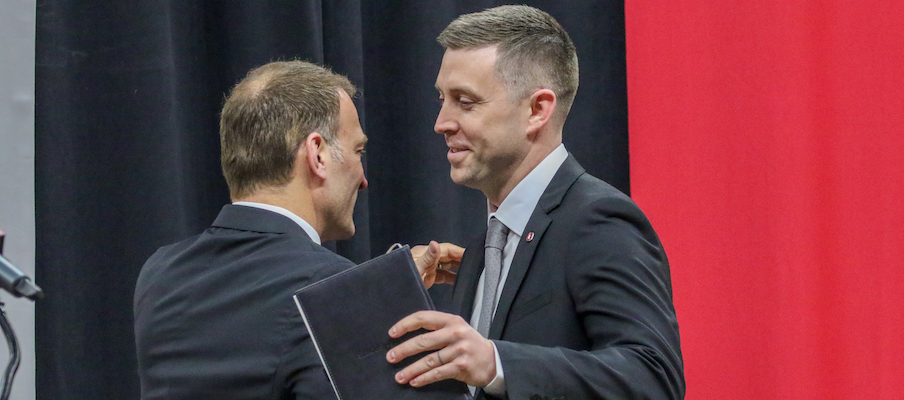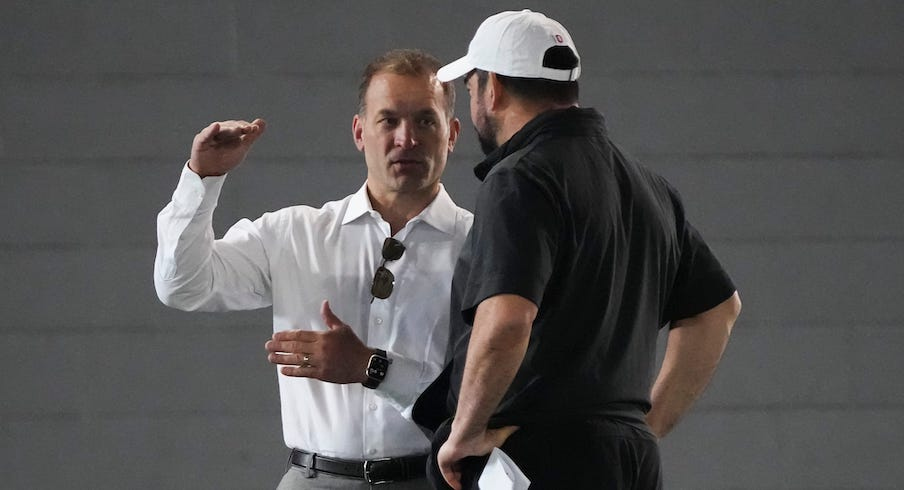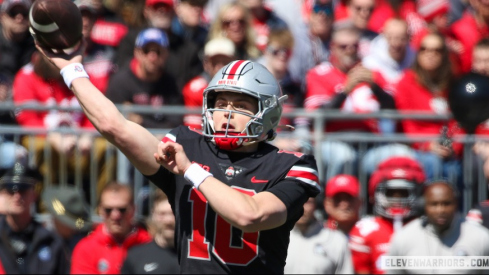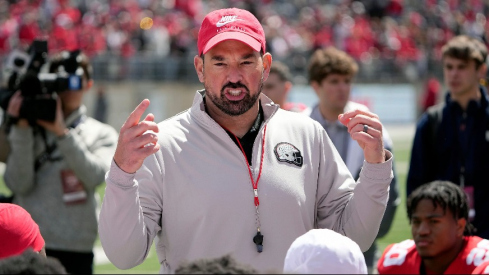The race to compete for championships in college sports will soon include a new variable.
As part of a new revenue-sharing model created by the NCAA’s settlement of three antitrust lawsuits, NCAA schools will be allowed to pay athletes directly starting in 2025. Per the settlement framework, the revenue-sharing for each school’s athlete pool will be capped at 22% of the average revenue brought in by Power 5 schools – a figure estimated to start at around $20-22 million per year with the potential to increase in future years.
While it’s unclear how Title IX will apply to the new revenue-sharing model, schools are expected to have flexibility in determining which athletes will receive a share of the revenue and how much each athlete will receive. As such, there’s little question that successful revenue-sharing strategies will become crucial to building championship-caliber rosters, particularly in the two sports that generate the most revenue, football and men’s basketball.
Ohio State appears ready to embrace the new model when it goes into effect next year. While OSU was overly cautious about working with collectives to arrange deals for athletes when name, image and likeness benefits were first permitted by the NCAA in 2021, sources have told Eleven Warriors that Ohio State has already been working behind the scenes for months to prepare for a future revenue-sharing model, signaling that the Buckeyes intend to be aggressive about using revenue-sharing opportunities to their advantage.
This new model will benefit student-athletes in major ways, this change has to be embraced allowing Buckeye Athletics to continue to be a premier program! https://t.co/sXCKZSGF1G
— Gene Smith (@OSU_AD) May 24, 2024
Having brought in a record-breaking $279.6 million in athletics revenue during the 2023 fiscal year, Ohio State should be as well-positioned as any school in the country to benefit from the new revenue-sharing model. That said, the new model could also create several challenges that OSU will have to reckon with.
While there are still many specifics to be determined before the new model goes into effect more than a year from now, we’re taking a first look at several ways – both positive and negative – in which the new model could impact Ohio State athletics.
OSU has more revenue to work with than any other school
Because the revenue-sharing cap is based on the average of power-conference schools’ revenues rather than each school’s individual revenue, Ohio State will be giving a much smaller piece of its pie to its athletes than most schools. If the cap starts out at $22 million, that would be less than 8% of Ohio State’s total athletics revenue from fiscal year 2023 – a number that will only increase going forward, as FY23 ended before the Big Ten’s new media rights deal went into effect.
Ohio State generated the most total revenue of any college athletic department in 2022 –the most recent year for which USA TODAY has compiled the revenue of every Division I public school – and if that continues to be the case, OSU will have more money to work with to fund its revenue sharing than any other school.
“We’re fortunate they all looking at all schools, so having certain schools in that calculation – if it was just Ohio State, it’d be more money, but when you look at the aggregate, there’s an average,” Ohio State athletic director Gene Smith said earlier this month during an appearance on WOSU’s “All Sides.”
While some schools will face tough decisions of whether they can afford to pay their athletes as much revenue as possible, Ohio State shouldn’t have to worry about that dilemma. That’s not to say the Buckeyes won’t have to make some cuts elsewhere (more to come on that), but OSU is as well-positioned as any school to max out its athlete revenue sharing while also continuing to invest in top-notch facilities, coaches and other resources for its programs.
Cap could mitigate OSU’s advantage
While Ohio State might have the deepest coffers of any college athletic department, it certainly won’t be the only school paying its athletes the maximum amount of revenue permitted to build the best rosters possible. Although the opportunity to share revenue with athletes will be a roster-building boon for the wealthiest programs in college sports, the cap serves to level the playing field among them rather than allowing any school to outspend their competition like the New York Yankees or Los Angeles Dodgers.
In the new world of college sports – particularly football – where revenue sharing will almost certainly be a necessity to retain top players and the recruitments of top prospects will become even bigger bidding wars than they already are, the cap will force Ohio State and other schools to make tough decisions – much like NFL teams have to with free agents –about which players it can afford to pay market value and who it will risk losing to other schools that might have more money available.
Ohio State should be well-positioned to continue retaining its star players and landing star transfers like Caleb Downs and Quinshon Judkins, but it could be at a higher risk of losing more recruiting battles for players who would be second-tier additions for the Buckeyes but top-tier additions for programs that haven’t been perennial championship contenders.
NIL will remain an asset for the Buckeyes
One of the biggest questions surrounding the new model is how NIL collectives will factor into the equation. It would be naive to think that schools won’t continue to look for every advantage they can get, but early reports have suggested optimism from college sports leaders that the new model will include a stronger enforcement arm that cracks down on schools using collectives as a means of funneling money to recruits in pay-for-pay deals.
Ohio State has had talks with its collectives about bringing them in-house to work within the athletic department to help OSU raise funds and arrange NIL deals for its athletes, and it’s expected that other schools will do the same. Either way, the NIL opportunities that will remain available to Ohio State athletes will be a major asset for the Buckeyes even as revenue sharing comes into the fold.
Few schools, if any, can match the combination of being in a major city and having the massive, passionate fan base that Ohio State does. As such, there will continue to be plentiful opportunities for Ohio State athletes to sign endorsement deals with local and national businesses, which will remain a key component of OSU’s recruiting pitch to its athletes.
Competing with basketball schools could become tougher
Because the revenue-sharing cap will apply to entire athletic departments rather than individual sports, each school will have to decide which sports it will prioritize in its revenue-sharing efforts. At Ohio State, there’s no question that football will be the top priority, as its top competitors for Big Ten and national championships are sure to give their football players a substantial portion of their revenue, too.
That could potentially hurt Ohio State when it comes to competing with men’s basketball powerhouses. While OSU will surely invest some of its sharable revenue into Jake Diebler’s program, it likely won’t be as much as basketball powers like Kentucky, Kansas, North Carolina, Duke, UConn, Indiana and Purdue – all schools, to name a few, that are far more likely to compete for basketball championships than football titles.
In a system where schools will be limited to sharing the same amount of revenue across all of their sports, it could become tougher than it’s ever been before to be elite in both football and men’s basketball simultaneously. That should continue to be the goal for Ohio State, but competing for national championships in football will be the primary objective.

Funding 36 sports will become tougher
Ohio State takes pride in fielding the most varsity sports teams of any school in the country, but the move toward sharing revenue with athletes could force OSU to reevaluate whether that remains a viable long-term strategy.
As only two of Ohio State’s 36 sports teams make more money than they spend, the other 34 sports have been largely subsidized by football revenues. Now that more of that revenue will be going to the athletes who help generate it, OSU will have less money available to fund the sports that don’t pay for themselves.
Soon-to-be athletic director Ross Bjork and new university president Ted Carter both said in January that they intend to keep all 36 sports, but outgoing athletic director Gene Smith acknowledged in April that continuing to fund all of those sports at a level where they can all compete for championships could become impossible.
“The way I look at it now, I think it’s going to have to be the expectations for the other sports (will change),” Smith said. “In the past, we've always had expectations for all of them to chase championships. Where realistically, if you're not providing all those resources that we currently provide, because you have to reduce their budgets in order to fund whatever comes at the top level, then you've just got to change your expectations. My guess is we'll still sponsor 36 sports, but X number will be sponsored at a different level of support, if that makes sense.”
In addition to setting up revenue-sharing with athletes, the new model is also expected to eliminate scholarship limits. While most athletes in non-revenue sports currently receive partial scholarships – college baseball teams, for example, can divide 11.7 scholarships among up to 27 players – the new model is expected to allow all athletes to receive full scholarships, potentially leading to millions of dollars in additional costs for OSU across its 36 sports.
Eliminating sports still appears to be a last resort for Ohio State; as Bjork noted in January, OSU doesn’t want the facilities created for those various sports to sit empty. If keeping all of those sports means no longer being able to provide all of those sports the resources they need to compete for championships, however, OSU could have reason to consider focusing on a smaller number of sports at which it can compete at the highest level.


